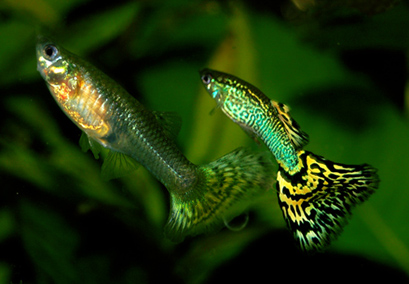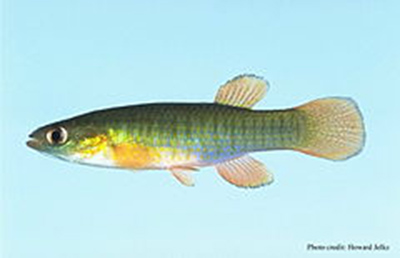Essay for February 2013: Rapid Evolution of Fish in a Stream
This month's essay was motivated by the article: The Great Guppy Experiment [1]. Although guppies live in fresh, not sea water, and are thus not part of Life on the Dock, the work is interesting and important, and clearly relevant to the animals and plants of the Dock.
The location
The stream is the Taylor River, in Trinidad and Tobago, an island about 30 km in diameter, 30 km off the coast of Venezuela. Portions of the river consist of segments of gentle flow, separated by falls. The small fish living in the river are unable to transverse the larger falls, and thus these segments represent isolated environments.
The animals
Guppies are the study animals. They are 3-6 cm long. A female produces 5-30 young (fry) in 28 days, and is able to breed again within hours. Thus there can be 3-4 generations per year.
Killifish are often neighbors of the guppies. They are slighty larger but only occasionally eat guppies.
Cichlids are the main predator of guppies (and killifish) in the river. This is a very diverse group, with sizes from 3 to 100 cm (1 meter, or a yard). Some cichlids have a flat body, e.g. angelfish, others are cylindrical in shape. Tilapia, which are an important human food, are cichlids. Cichlids also grow and reproduce rapidly, and have been the subject of many studies of evolution.
Techniques and methods
In some river segments there are no guppies, and the researchers introduce 40 males and 40 females. Individual fish are "tatooed" by inserting tiny colored discs of plastic under the skin. They use 12 colors, and there are 8 different possible sites of injection; thus all the founders in a river segment can be uniquely marked.
A single scale from a guppy contains sufficient DNA to easily obtain the nucleotide sequence of the fish. Thus it is possible to determine the parents of the new guppies that are produced and thus to determine the reproductive success of families.
Results
Many results are clear after a decade of work. Relative to guppies in upper isolated river segments, guppies in lower segments that contain cichlids, have a dull color, reproduce fast, and mature at a small size. When the guppies from lower segments are transplanted to upper ones, they aquire the characteristics of the upper guppies in just a few years. These are genetic changes, not reversible adaptations. Thus we are observing evolution in real time.
Many aspects of the environment have been documented during this study, e.g. effects of tree cover, insect populations, water velocity etc. These river segments thus combine many of the desirable characteristics of laboratory and wild environments.
The future
While some studies of this system were started several decades ago, the work described in the reference below(which is not a scientific report, but rather a news summary of the status of the project) was initiated in 2006, with a buget of $5 million. It now seems that there will be no more funding. This seems a false saving, since a large data base of observations has been created. The results described in the preceeding paragraph is just a small sample of what can be obtained by examining the data, many more results are sure to be obtained in subsequent publications. However, the value of the project would most likely be increased considerabley is it were to be extended another decade.
References
[1] The Great Guppy Experiment. Elizabeth Pennisi, Science (24 Aug 2012) v337, pg 904 http://www.sciencemag.org/content/337/6097/904.summary
Unfortunately this article is not "open access", so you must have a subscription to Science, or access to a library that has one, or wait 6 months after the publication date to get access to the entire contents.


